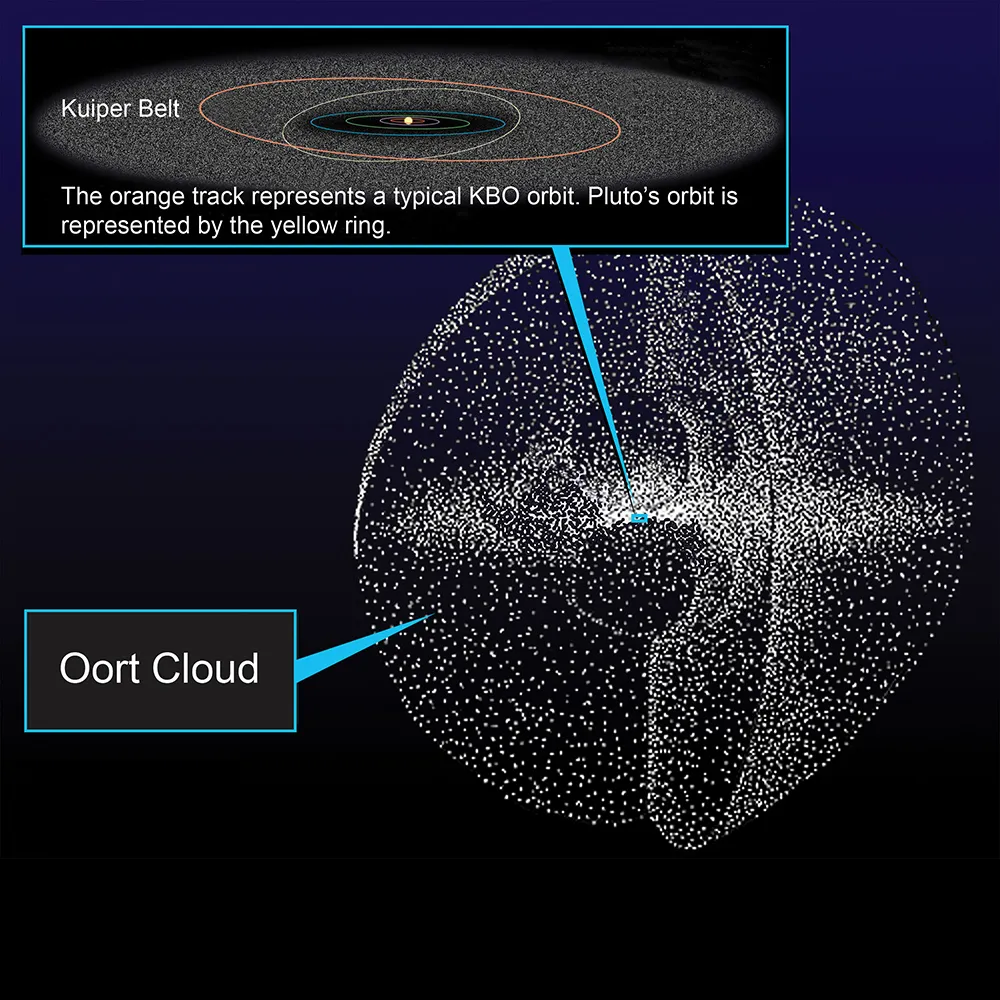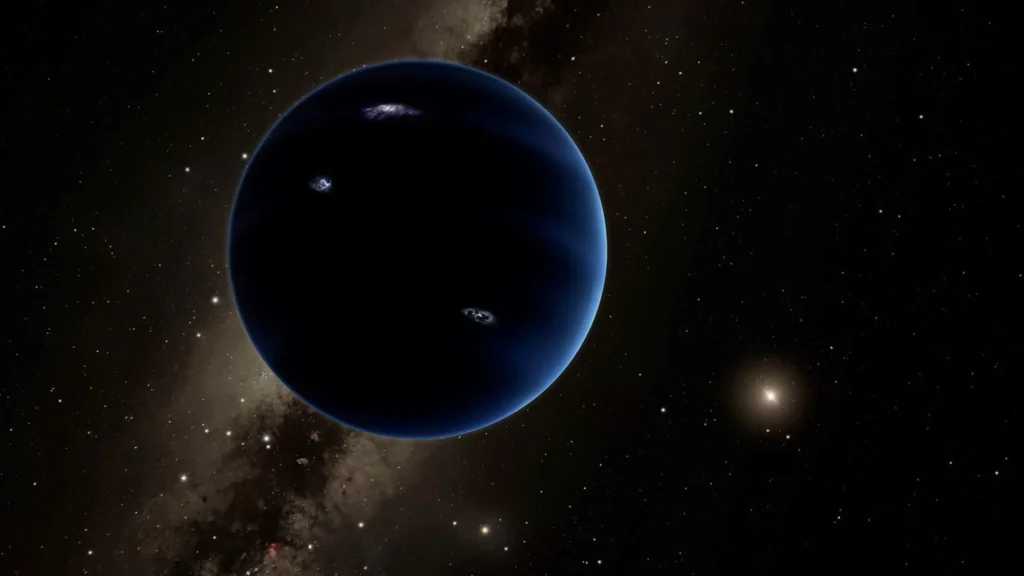Humanity has always gazed at the stars with a sense of wonder, pondering the mysteries that lie beyond our reach. The search for new worlds within our own solar system has been a persistent theme in astronomy, from the historical pursuit of the hypothetical Planet X to the recent discovery of numerous exoplanets orbiting distant stars. But what if our quest for the unknown doesn’t need to venture light-years away? What if, right here in our own backyard, the Oort Cloud holds secrets far grander than we ever imagined – giant, undiscovered planets silently orbiting in the icy depths?
The Enigmatic Oort Cloud
The Oort Cloud is a vast, spherical shell of icy objects that envelops our solar system. It’s estimated to extend trillions of miles from the Sun, far beyond the orbit of Neptune and even Pluto. This frigid region is a relic of our solar system’s formation, a graveyard of icy debris leftover from the birth of planets.
While astronomers have theorized about its existence for decades, the Oort Cloud remains largely unexplored. Its immense distance and the faintness of its objects make direct observation incredibly challenging. However, scientists believe it contains trillions of icy bodies, ranging in size from small pebbles to dwarf planets.
Recent studies, including complex computer simulations conducted by researchers from CNRS in France, indicate that the Oort Cloud might harbor more interstellar objects than previously believed.
Could there be planets in the Oort Cloud?
Astronomers have debated the possibility of planets in the Oort Cloud for many years. Some believe that planets could have formed in the Oort Cloud during the early solar system, while others believe that they could have been captured from other star systems.
A recent study by a team of international researchers suggests that there is a 7% chance that our solar system has another neighboring planet hiding in the Oort Cloud. The researchers used computer simulations to model the formation and evolution of the solar system, and they found that planets can be captured into the Oort Cloud during the early solar system.

Evidence and Speculation
While direct evidence for giant planets in the Oort Cloud remains elusive, several lines of evidence and theoretical models suggest their existence is plausible:
- Theoretical Models: Models predict that the Oort Cloud could contain a significant number of objects larger than 1 km in diameter, including potentially planet-sized bodies. These models are based on the idea that the Oort Cloud is a reservoir of icy bodies that were scattered from the outer solar system during the formation of the solar system.
- Captured Planets: Research suggests that up to 10% of planets in a young solar system could be cast off into interstellar space. This means that there is a small chance that a planet from another solar system could have been captured by our solar system and now be present in the Oort Cloud.
- Long-Period Comets: The Oort Cloud is thought to be the source of most long-period comets, which have orbits that take more than 200 years to complete. These comets are believed to originate from the Oort Cloud and are thought to be remnants from the early days of the solar system.
- Detection Challenges: The detection of planets in the Oort Cloud is difficult due to their immense distance from the sun and the faintness of their signals. However, future surveys like the Vera C. Rubin Observatory, expected to commence science operations in 2025, could potentially spot such a planet if it is in a favorable position in the sky.
- Theoretical Astrophysicist Amir Siraj: Siraj has calculated that there could be 1.2 planets with a mass greater than Mars, 2.7 with a mass comparable to Mars, and 5.2 with a mass comparable to Mercury. These estimates are based on the likelihood of rogue planets passing close enough to the sun to be captured by its gravity.
Captivating Discoveries and Statistical Possibilities
Scientists estimate that up to 10% of a star’s original planets may be cast out into the depths of space. Astonishingly, there is a 7% chance that our solar system might have captured an ice-giant planet like Uranus within the Oort Cloud. They further hypothesize that one in every 200 to 3000 stars could potentially host an Oort Cloud planet. Nevertheless, it is important to note that these predictions might be overestimations due to various factors such as early-stage solar system instabilities or planet stripping caused by passing stars.
ALSO READ: Facts About Mercury: All You Need to Know
Could giant alien worlds be hiding in the Oort Cloud?
The possibility of giant alien worlds in the Oort Cloud is a fascinating one. However, it is important to note that this is still just a hypothesis. There is no concrete evidence that giant alien worlds exist in the Oort Cloud, or anywhere else in our solar system for that matter.
However, the idea of giant alien worlds in the Oort Cloud is certainly plausible. The Oort Cloud is a vast and mysterious region of space, and we have much to learn about it. It is possible that the Oort Cloud could be home to all sorts of amazing objects, including giant alien worlds.
Future astronomical surveys, such as the Large Synoptic Survey Telescope (LSST), could help to shed light on the contents of the Oort Cloud. The LSST will be able to scan the entire sky every few nights, which could lead to the discovery of new objects in the Oort Cloud, including giant alien worlds.
What kind of planets could be in the Oort Cloud?

If there are planets in the Oort Cloud, they are likely to be ice giants similar to Uranus and Neptune. This is because the Oort Cloud is so far from the sun that it is too cold for rocky planets to form.
Ice giants are thought to be common in the universe, and they have been found orbiting many other stars. However, they have not yet been directly detected in our solar system.
How could we find planets in the Oort Cloud?
Finding planets in the Oort Cloud would be very difficult. They are very far away and they are likely to be very small and dark. However, there are a few ways that we could try to find them.
One way would be to look for perturbations in the orbits of long-period comets. If a planet is orbiting in the Oort Cloud, it could gravitationally perturb the orbits of comets as they pass by. This could cause the comets to change their orbits or even break apart.
Another way to look for planets in the Oort Cloud would be to use gravitational lensing. Gravitational lensing is a phenomenon where the gravity of a massive object bends the light from more distant objects. If there is a planet in the Oort Cloud, it could lens the light from the stars behind it. This would make the stars appear brighter and more distorted.
Conclusion
The Oort Cloud, a vast and mysterious realm at the edge of our solar system, holds secrets that have yet to be revealed. The existence of giant alien worlds within this icy expanse remains a tantalizing possibility, one that could reshape our understanding of planetary systems and ignite our imaginations. As technology advances and our ability to explore the depths of space improves, we may one day unveil the hidden giants that lurk in the darkness, expanding our cosmic perspective and reminding us of the infinite wonders that await discovery.
Also read :
